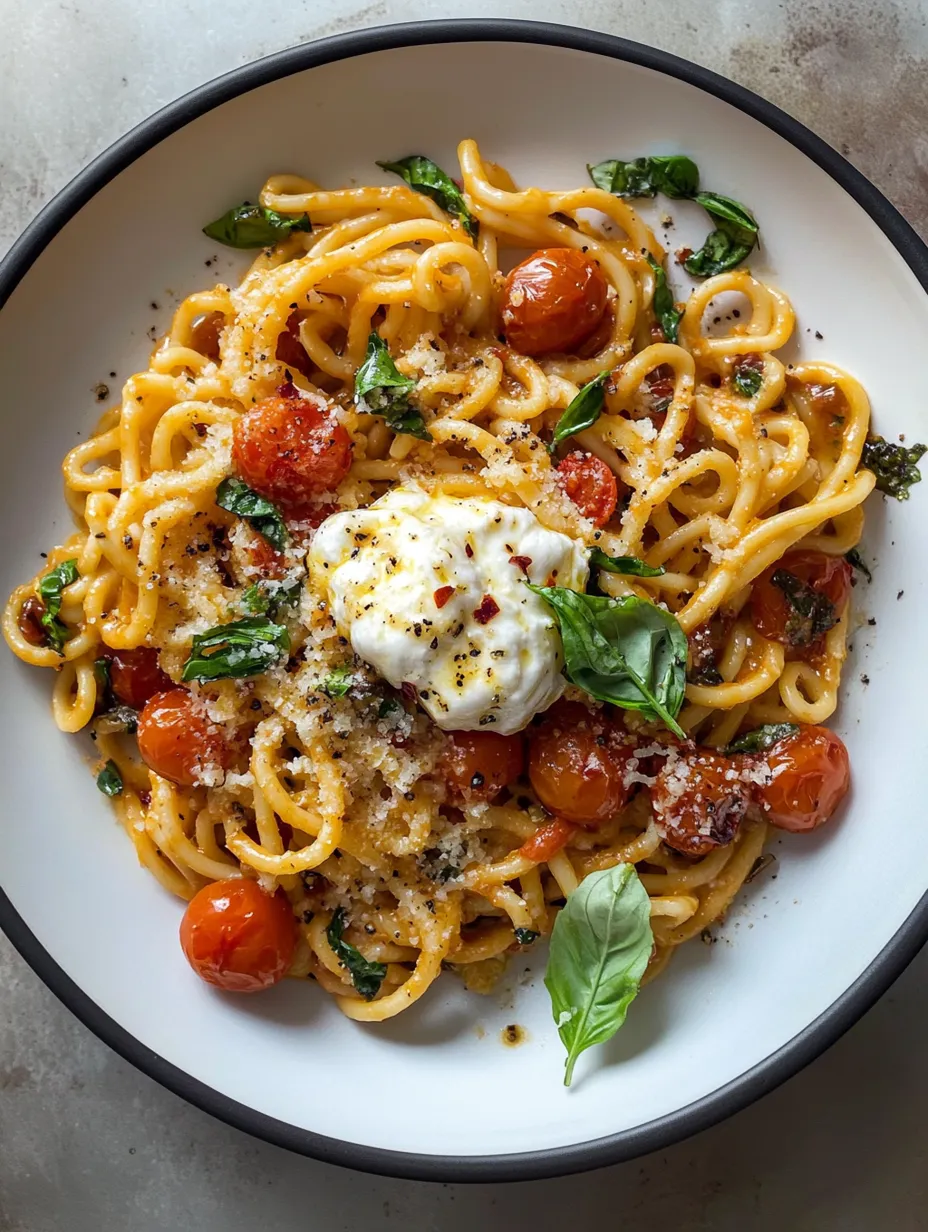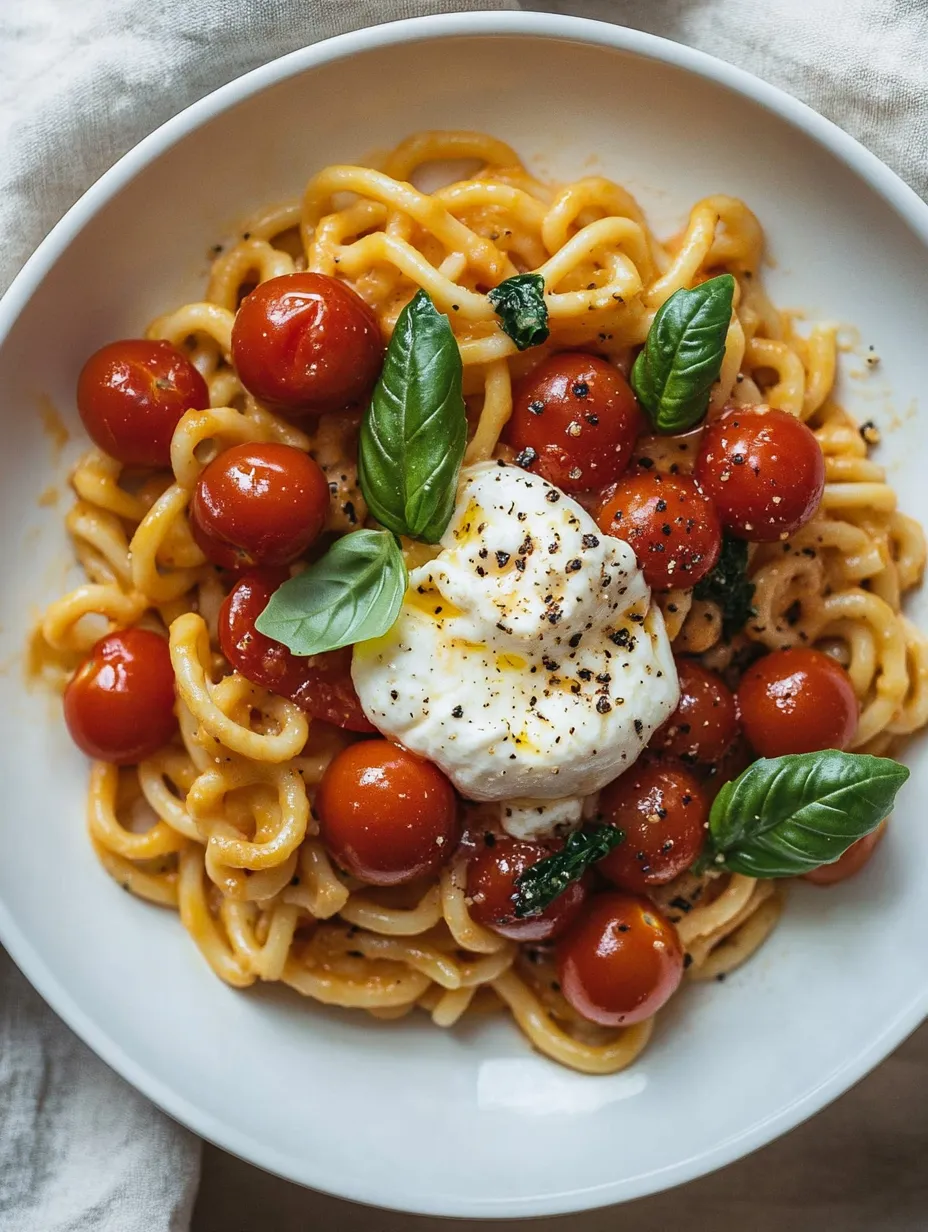 Pin it
Pin it
This burst tomato burrata pasta came into my life during that crazy hot week last summer when turning on the oven seemed like a personal attack on my air conditioner. I was staring at a container of cherry tomatoes that were about a day away from getting too soft, and I remembered a dish I'd had at this little Italian place in the city. The combination of slow-cooked tomatoes, creamy burrata, and plenty of garlic has this magical way of feeling both simple and fancy at the same time. First time I made it, my husband took one bite, looked at me with genuine confusion and asked, 'How is this so good with so few ingredients?' Now it's our go-to for impromptu dinner guests or weeknights when I want something that feels special without actually requiring much effort.
Last month when my friend Sarah stopped by unexpectedly around dinner time (you know, that friend who's always 'just in the neighborhood'), I threw this together while we caught up over wine. She literally pulled out her phone mid-bite to take notes on the recipe. My teenager, who has recently decided that vegetables are suspicious, ate a full plate without complaint and then hung around the kitchen eyeing the leftovers. There's something about the combination of jammy tomatoes and creamy cheese that seems to work magic on everyone.
Ingredient Magic
- Cherry tomatoes: Transform into something completely different when given time to slowly cook down – they get this amazing concentrated sweetness that you'd never expect
- Burrata: Brings that dramatic moment when you cut into it and the creamy center spills out, creating little pockets of richness throughout the pasta
- Fresh basil: Added at the end gives that bright, aromatic punch that makes everything taste alive and summery
- Red pepper flakes: Provide just enough heat to wake up your taste buds without overwhelming the delicate flavors
- Good olive oil: Isn't just a cooking medium here – it becomes part of the sauce, so use the good stuff if you have it
 Pin it
Pin it
Step-by-Step Instructions
- Cooking garlic:
- The garlic cooking process is more important than you'd think. First time I made this, I rushed it and barely let the garlic soften. Now I give it a full 1-2 minutes to gently cook in the oil, which infuses everything with that mellow garlic flavor without any harsh bite.
- Bursting tomatoes:
- Don't rush the tomato bursting process! My initial attempts, I got impatient and cranked up the heat, which caused the tomatoes to burst too quickly and not develop that deep, jammy flavor. Low and slow is the name of the game – those 20-25 minutes are mostly hands-off anyway, perfect for pouring yourself a glass of wine and pretending you're slaving away over a complicated sauce.
- Selecting pasta:
- The pasta selection matters more than you'd think. I've tried this with all sorts of shapes, and long pasta like spaghetti or bucatini really does work best because it gets completely coated in that amazing tomato mixture. Those little hollow strands of bucatini fill with sauce and create the perfect bite.
- Adding pasta to skillet:
- Adding the pasta directly from the pot to the skillet brings just enough starchy pasta water to help bind everything together. The first time, I drained and rinsed the pasta (a habit from other recipes) and the sauce didn't cling nearly as well.
- Incorporating burrata:
- The burrata incorporating technique evolved through experimentation. Initially I just placed it on top for 'aesthetic,' but now I gently break it up and stir some through the hot pasta, which creates these amazing little pockets of creaminess throughout, while still leaving some visible on top for that wow factor.
- Adding basil:
- Fresh basil timing is crucial. I've learned to add it after turning off the heat – those few moments of residual warmth release the flavor without turning the leaves dark and wilted.
My first version of this dish was pretty basic – just tomatoes, garlic, and cheese. It was good, but over time I've found that the dried basil adds depth to the sauce while the fresh basil at the end adds brightness. The red pepper flakes bring just enough heat to keep things interesting. I've experimented with adding shallots to the initial oil, but honestly found that the simplicity of just garlic was better – sometimes less really is more.
Serving Suggestions
Serve this family-style, right in the skillet if you want to minimize dishes. For a complete meal, I sometimes add a simple arugula salad dressed with lemon and olive oil to cut through the richness. A crusty baguette on the side is perfect for sopping up every last bit of that tomato sauce. This pairs beautifully with a crisp white wine like Pinot Grigio or a light red like Chianti, depending on what you're in the mood for.
Seasonal Swaps
During peak summer when basil is taking over my garden, I double or triple the amount for an even more aromatic dish. In winter when good tomatoes are harder to find, I actually think cherry tomatoes still work well, but a splash of balsamic vinegar added to the sauce helps boost their flavor. For a heartier version in cooler months, I sometimes add a couple handfuls of baby spinach right before adding the pasta, letting it wilt into the sauce.
Storage Notes
This pasta is definitely best eaten fresh, when the burrata is still warm and melty. That said, leftovers can be stored in the fridge for a day or two – just know that the burrata will firm up. Reheat gently in a skillet with a splash of water or olive oil to loosen things up. I don't recommend freezing this one – the texture of both the pasta and cheese suffers too much.
 Pin it
Pin it
I've made this burst tomato burrata pasta for casual weeknight dinners, for last-minute guests, and even once for a date night in when I wanted to impress without spending hours in the kitchen. There's something deeply satisfying about creating something so delicious from such simple ingredients. My family now knows that when they smell garlic and see cherry tomatoes in the shopping bag, this pasta is likely on the menu – and no one is ever disappointed. What started as a way to use up some rapidly aging tomatoes has become one of our most requested meals, proof that sometimes the simplest dishes are the ones we come back to again and again.
Frequently Asked Questions
- → What is burrata cheese and where can I find it?
- Burrata is a fresh Italian cheese made from mozzarella and cream. The outer shell is solid mozzarella while the inside contains stracciatella and cream. It's usually available at specialty cheese shops, Italian markets, and many well-stocked grocery stores.
- → Can I substitute the burrata with something else?
- If you can't find burrata, you can substitute with fresh mozzarella, though the dish won't be quite as creamy. For a similar creaminess, you could add a splash of heavy cream to the sauce and top with torn mozzarella.
- → How do I know when the tomatoes are properly burst?
- The tomatoes should be soft and many will have split open, releasing their juices. Some may still be whole but very soft. The juices should have created a sauce with the olive oil.
- → Can I make this pasta ahead of time?
- The tomato sauce can be made ahead and refrigerated for 2-3 days. Reheat gently before adding fresh pasta and cheese. However, the burrata should be added just before serving for the best texture and flavor.
- → What other herbs would work well in this dish?
- This pasta is very versatile! Try fresh oregano, thyme, or mint in addition to or instead of basil. A handful of arugula tossed in at the end also adds a nice peppery flavor.
